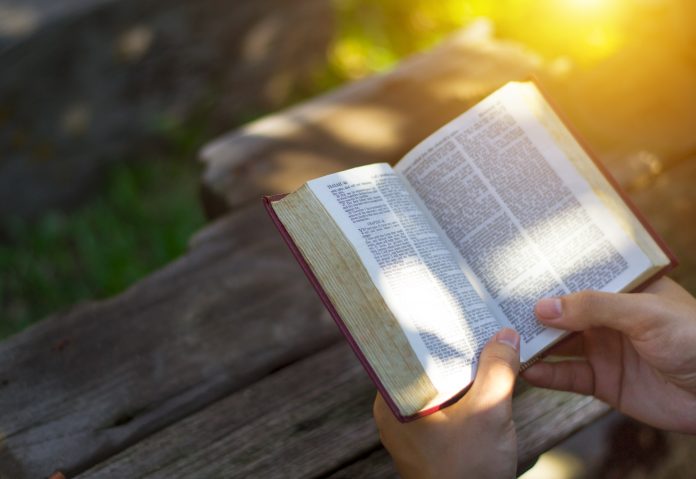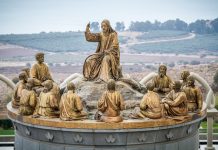
JOYCE M. KELLEHER
How can we help our students and ourselves become more aware of how the living force of God’s Word is active in our lives?
Let’s begin with this true story:
It was the First Sunday of Advent. The children were gathered for their celebration of Liturgy of the Word. The Gospel that Sunday told the story of the master who left his servants in charge of the household while he went on a journey (Mark 13:33-37). In this Gospel, Jesus tells his disciples, “Therefore, keep awake, for you do not know when the master of the house will come.”
After proclamation of the Gospel, the children’s lector asked, “What did we hear? What do you think this story can mean?” After some discussion, one child remarked, “I think we are like the servants and Jesus is like the master. We are supposed to take care of things until Jesus comes back.”
Upon hearing that, one little boy, about nine years old, jumped up in great excitement and exclaimed, “Is he coming back? Is Jesus coming back?” The children assured him that, indeed, Jesus was coming back as he promised. The boy responded, “Does anyone else know this? Does my mom know this? I can’t wait to tell her!”
Does anyone else know this? This was not the child’s first exposure to Scripture nor was he new to religious education. By fourth grade, he and his class would have learned about the Second Coming of Jesus. What was it that brought about this discovery and new meaning?
Personally Encountering the Word
Our religion textbooks usually use Scripture to fit the topic of a lesson to be learned. There usually are exercises, questions, and an activity to reinforce the points of the lesson. This approach can be used effectively to teach doctrine, but it has significant limitations if our goal is to help those entrusted to us to apply the Word of God to life.
If the textbook method is the only one we use, we risk restricting the meaning of the Scripture passage to just the few points being taught, rather than leaving the dynamic Word of God open to speak to us over a lifetime in many different situations. We risk just teaching about God instead of creating opportunities to experience God. For children especially, this can lead to equating Scripture with their religion textbook that all too often is treated as just another school subject.
Our nine-year-old in this story came to his exciting realization even though he had certainly heard the Scripture before. The difference was the open-ended forum of Liturgy of the Word with Children. For this child there was the opportunity for conversation, listening to others, mulling over ideas, and then so joyfully coming to his own understanding that he couldn’t wait to share it! This was not a lesson with points to be learned. The children’s lector did not try to “teach” the Word or emphasize elements of doctrine. Rather, the lector trusted the power of the Word to speak to the children’s hearts according to their own needs and on their own timetable.
The work of connecting Scripture to life must be done by those who are living their lives, not by others. We are the only ones who can bring perceptions of our individual experiences to the Word. We cannot do this for others because we do not know what their varied experiences might be. Only by doing this work ourselves will we learn to make faith-based decisions. Only in this way will we feel and live in God’s love, acceptance, and forgiveness as intended for our lives.
Individual Reflection
Catechesis presumes conversion and conversion presumes that one has heard God’s Word and responded to it. Therefore, a key element of catechesis for any age is the opportunity for reflection on the Word of God, particularly the Sunday Gospels.
Whenever possible, individual reflection should be shared with others. When we draw from participants what they hear God saying to them, our method is consistent with the basic Christian belief that each person is a temple of the Holy Spirit, a living source of God’s self-revelation (1Corinthians 6:19). This is how we begin to see that God is directly involved in our lives and intimately connected to our everyday experiences.
Lectio Divina
Fortunately, the Church tells us how to do this! In the document “The Word of God in the Life and Mission of the Church,” we read, “It is important to remember that the Word of God in catechesis should not be seen as a mere object of academic study. Instead, from the vantage point of Revelation, encountering Sacred Scripture in catechesis is to be understood as an act with which God himself speaks to people, as he does in liturgical celebrations. The biblical texts are to communicate an experience of the abiding and gracious presence of God, who does not cease to manifest himself to humanity. In this manner, catechesis is closely bound to Lectio Divina which itself is an experience, originating at a young age, of listening to and praying the Word of God” (n. 44).
Lectio divina, or “holy reading,” is a slow, prayerful way of meditating on Scripture and applying its insights to one’s life. It is a treasure of our heritage in which we come to see our personal experiences in light of God’s Word and apply the Word to our lives.
How can we use this method for ourselves and our students? We can simplify the method of lectio divina into three steps and models anyone can follow. Ideally, as catechists, we will reflect on the Sunday Gospels according to one of these models each week as we prepare for our catechetical sessions. Ideally, as well, we will carve out time at least once each month for our students to reflect with one another during class.
When we use one of these models in a group, it is important to remember to let those entrusted to us arrive at their own insights as to how God is at work in their lives. We can do this by asking open-ended questions rather than by giving answers or telling the participants what they are supposed to get out of the scriptural passage. It is a moment for us, as catechists, to put aside our teaching role and to become co-listeners. It is an exercise in humility, reminding us that there is only one teacher, the Lord Jesus himself. We must practice getting out of the way so that the Word of God can speak.
Model One is best suited for older children and adults who have 30 minutes or more for reflection.
Step One: God’s Word
1. Read or listen to the Scripture.
2. Reflect on words, phrases, or messages that capture your attention.
3. Imagine yourself in the scene and feel what it is like to be present.
4. Example: Read the story of Jesus and his disciples caught in a storm at sea while Jesus is asleep (Matthew 8:23-27). What is it like as you imagine yourself in the boat? What do you say to Jesus when he asks why you are afraid?
Step Two: My experience
1. Choose several verbs from the passage that captured your attention. Insert them into these questions: a) When did I/have I ___? What was it like? b) To whom or with whom did I ___ and how did it feel? c) Who ___to me? How did it feel?
2. What insights have I gained from this reflection?
3. Example: What is it like for me to be afraid? What are some storms I have faced in life? Who has helped me calm those storms? How has my faith helped me?
Step Three: My response
1. What will I do in response to my reflections?
2. What needs to change in my life?
3. What needs to be added to my life?
4. How am I called to be a better disciple in light of the Scripture story and my reflections?
5. Example: How can I bring the calming peace of Jesus to those who are afraid? How can I learn to trust more in Jesus’ loving care?
Model Two can be used even if older children and adults have just 15 minutes. It is also effective within Liturgy of the Word with Children.
Step One: What did I hear?
Example: In the story of the Last Supper, I imagine myself at the table. What thoughts, ideas, and feelings do I have as I see Jesus breaking the bread and serving it to me? What do I say to him?
Step Two: What does the story mean to me today?
Example: When have I felt as bread broken in my life? When have others broken themselves as bread for me?
Step Three: What is the story asking of me?
Example: What is Jesus asking of me today? How can I be bread for those who hunger for friendship, food, shelter, forgiveness, and the like?
Model Three is suitable for very young children but can be used by all.
Step One: What did I hear?
Step Two: I wonder what this story can mean?
Step Three: What can I say to Jesus for this great gift?
Conclusion
We are constantly observing and absorbing the world around us. We make judgments or draw conclusions about what we have observed. Then we respond to those judgments and conclusions by making choices in how to live.
When we follow this process of reflection on experience in light of the Gospel, we nurture a Christian conscience and a way of seeing the world through the Word of God. This becomes how God speaks to us today. It becomes as natural as breathing in and breathing out. In this way, we can see that God is directly involved in our lives, not disconnected from everyday experience. We come to see our personal experience in light of God’s Word so the God we come to experience is not “out there” but a personal, intimate God here with us in the reality of life.
And we begin to see that the stories of our lives are part of the unfolding larger story of God’s unending love for us, generation after generation.
If we work at making this kind of reflection a habit, we soon will see that the Word of God applies to every aspect of our lives. Like our young friend in the opening story, we will become so filled with joy at that knowledge that we, too, will say, “I can’t wait to tell!” And isn’t that why you became a catechist?
For Reflection
* How does sacred Scripture set a fire in my heart?
* When have I been surprised by an insight from sacred Scripture?
* How do I approach reading sacred Scripture? Am I scared? Hungry? Curious? Eager?
* How often do I read/reflect on God’s Word?
* Have I been in a Bible study group?
* Where do I experience the Word of God?
* What is it like for me to identify the story of my life with the larger story of God’s love for all of us?
* What are some ways I have come to see the story of my life as part of the larger story of God’s unending love?
* How does this method of reflection put me in touch with God’s action in my life today?
* How does my reflection challenge me in the life and work of Jesus in my time and place?
* How will I use these models for applying the Word of God to life?
Resources
Gobbi, Gianna. Listening to God with Children: The Montessori Method Applied to the Catechesis of Children (Treehaus Communications, treehaus1.com)
Roberto, John ed. Living Well: Christian Practices for Everyday Life. Chapter 7, “Reading the Bible” (available at lifelongfaith.com)
Kelleher, Joyce M. Turning Points: Rethinking Conventional Catechesis (Treehaus Communications, treehaus1.com)
Study Guide
The objective of Joyce Kelleher’s article is to offer a few ideas for integrating Scripture into your lesson plans. With over 40 years of catechetical experience, Kelleher offers three basic models for application. We encourage you to consider the models in relationship to the six previous articles in the series. By applying your creative religious imagination, you are invited to design six or more additional models; thus, you may begin to develop a scriptural portfolio of lesson plans, resources, or prayer experiences.
Discussion/Reflection Questions
1. How does the religion textbook I use integrate Scripture into lesson plans? What have I found most helpful in the book? Not so helpful? What guidance can enhance my application of Scripture into my lessons?
2. Is the textbook method the only one I use? Why? If not, what other methods do I use? (Give a few concrete examples.)
3. How can a catechist create opportunities for students to authentically experience God? How does a catechist know if it is an authentic experience of God?
4. How could I adapt one of the models presented by Kelleher in one of my lessons or catechetical experiences? (Describe.)
5. What are some ways I have come to see that the story of my life is part of the larger story of God’s unending love? (Explain.)
6. How does this method of reflection put me in touch with God’s action in my life today?
7. Reflecting upon this entire catechist formation series (all seven articles), what has been my most significant learning experience?
8. What impact has reading, reflecting, praying over, and discussing these articles with friends or other catechists had on strengthening my catechetical ministry?
9. What ongoing questions do I have about the Scriptures? What other faith formation courses, workshops, or seminars might I pursue in the future?
Exercises
1. Visit the website vlc.udayton.edu and explore online courses to expand and enhance your biblical understanding.
2. Review the methodological guidelines presented in the National Directory for Catechesis at n. 21C (The Process of Inculturation); n. 25I (The Promotion of a Common Language of Faith in Transmitting the Christian Message); and n. 28B (Catechesis and Divine Methodology). How can you apply these fundamental objectives to your lesson plans?
Related Resources
shc.edu/theolibrary (Theology Library)
jesuit.ie/prayer (Sacred Space)
lonergan-Iri.ca (Lonergan Research Institute)
bible-researcher.com/links09.html (Roman Catholic Biblical Studies)
cba.cua.edu/pub.cfm (Catholic Biblical Association of America)
bustedhalo.com (podcast on faith questions hosted by Paulist Fathers)
delasalle.org/resources (sponsored by the De La Salle Institute of the Christian Brothers, offers a collection of prayer services)
littlerockscripture.org (Scripture study materials)
rc.net/wcc/readings (daily Scripture readings and meditations)
Joyce Kelleher, now retired, was the Secretary for Catechetical Services in the Diocese of Cleveland. She holds a bachelor’s degree in secondary education from Northwestern University and a master’s of arts in systematic theology from St. Vincent Seminary, Latrobe, PA. Mrs. Kelleher taught in both public and Catholic high schools and colleges and has been involved in religious education for 42 years as a volunteer catechist, parish DRE, diocesan director, and seminary instructor. She is a speaker, consultant, trainer, and workshop leader for parishes and dioceses.
This article was originally published in Catechist magazine, February 2010.
Image Credit: Shutter Stock 530394964




